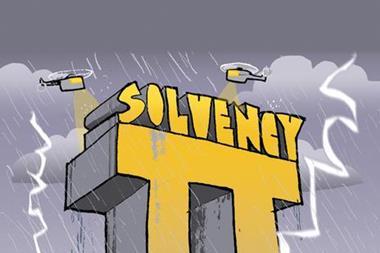Ready or not, it’s coming. We report on the second roundtable discussion on Solvency II, and finds that insurance industry experts believe the directive will mean greater management involvement in portfolios and more transparency. But is the process becoming a little too ambitious?
With the 2013 deadline for the introduction of Solvency II looming ever closer, Insurance Times held the second of its roundtable discussions on the far-reaching directive earlier this month.
Chaired by Lansons Communications director Richard Hobbs and Insurance Times deputy editor David Blackman, the debate focused on the industry’s preparedness for Solvency II, and whether the directive will undermine the competitiveness of the EU’s insurance industry.
Unum head of audit David Butler said: “Broadly speaking, the directive is sensible. But what we need to question is whether it’s going to turn out that way in practice and whether it gets overly complex. It’s about ‘what is the right standard we push for?’ As the implementation measures have come through from Ceiops [the Committee of European Insurance and Occupational Pensions Supervisors] and from national regulators, the standard appears to be going from building a bicycle to building a rocket.
“It seems to be getting incredibly complicated and extremely expensive. My questions are: ‘Do we really want to go that far? Is it sensible?’”
The panellists agreed there is real risk that the desired outcome from the Solvency II directive could be largely unachievable. ABI assistant director of financial regulation and taxation Paul Barrett asked: “How neurotic are we going to get about this? How do we make a sensible judgment about what is an appropriate standard? How do we document it?”
Previously unseen data
Zurich Solvency II programme manager Jérôme Berset voiced concern that the level of data accuracy required under the directive goes beyond that needed for internal risk management, adding: “We get the impression that [regulators] want to take the chief risk officer seat in our company.”
Barbican director of risk and governance David Russell agreed: “Whether you’ve got the model correct to three decimal places is beside the point. If the number is 60% as opposed to 60.234%, it actually doesn’t matter. When there’s trouble, there’s trouble.”
QBE head of enterprise risk management Justin Skinner expressed his concern about the implications of investors accessing previously unseen data. Brit Insurance Solvency II programme director Toby Ducker agreed. He said balance sheets will have to be viewed in a different way because they will be exposed to a new level of volatility.
However, Ducker was quick to point out that Solvency II could have positive effects, such as forcing liability underwriters to use more forward-thinking strategies. “It’s going to force them to underwrite for underwriting profit. They’re being forced to make those decisions in an active way, as opposed to passively allowing it to wash through the portfolio.”
Greater accountability
Ducker argued that the industry must learn to stand by a certain price structure. “It’s being brave enough to not chase market share, having the strength to not be a price-taker, but actually to know what your price is and be prepared to stick to it. If you’re going to make a loss, then make that decision that you’re going to make a loss.”
Unum’s Butler said such a changed mentality would strengthen insurance businesses by encouraging managements to get closer to their underwriting portfolios. “If effective capacity is a function of capital deployed into a certain sector or line of business, then the allocation of that capital suddenly becomes very, very meaningful and really does hit home at the front line in terms of distribution and underwriting.”
Another positive consequence of Solvency II, according to Brit’s Ducker, will be greater accountability. “They have to have a huge amount of transparency about the decisions they’re making. It makes them fully accountable in an extremely transparent way from the underwriters all the way up to the chief executive. That responsibility will ultimately benefit the insurance marketplace,” he said.
Ducker questioned what the directive will mean for discerning policyholders. “Will they recognise any difference from yesterday, apart from potentially a higher price or a slightly different contract wording? Will they actually see the benefit in terms of product structure or price? How well prepared are they to adopt some of the change that is coming their way?
“One gets the sense that while insurers are talking about this almost endlessly now, the conversation with policyholders and even, to a degree, brokers has barely started. Yet it’s going to take a while to prepare them for what we see as the coming changes.”
The ABI’s Barrett argued that consumers could benefit from the directive. He said: “You’ll be teasing out what customers actually need: you give it to them, and take out all the things they don't need. The frills and spills will be stripped away and priced.”
QBE’s Skinner suggested that policyholders may ultimately benefit from being able to construct their own product for their own needs.
Standard formula
Discussions then moved onto QIS (Quantitative Impact Study) 5, the test exercise for Solvency II, which has just concluded.
Skinner said that although insurers have been told they must complete QIS5 to their “best effort standard”, for many, the data required simply does not exist, nor is what they have appropriate.
“As a large commercial insurance company, we have no intention of using the standard formula because it doesn’t work for a commercial insurance business,” Skinner said, adding: “Ultimately it’s not of too much value to us to get the standard formula right, because it’s never going to work for us, and I’d prefer to focus my effort on the planning, delivery, and internal model aspects of Solvency II, which is where we should be putting our focus.”
Brit’s Ducker disagreed with Skinner’s view that QIS5 has not been valuable. He said: “We were in the fortunate position of starting a little bit early on the exercise. We used it as an opportunity to build the system for the standard formula. We will need to use that anyway for the first two years, even if we have an internal (model) approved.” Ducker added that the exercise has also forced insurers to accelerate the compilation of reliable data.
While Skinner agreed with Ducker, he added that one of the most significant yet least-discussed benefits of QIS5 is that it has accelerated work on technical provisioning. He said this has been lax by regulatory standards.
Turning to the issue of reserves, Ducker commented that it is highly beneficial that QIS5 is being calculated during a time of low interest rates.
He said if the calculations were being made when rates were high, there could be confusion if there were sudden movements in yields. “It also suddenly ties insurance markets – which to a degree have been counter-cyclical in terms of the economic cycle historically – much closer to the economic cycle because of that yield curve attachment into the liabilities.”
The panellists concurred that the QIS5 exercise has highlighted concerns about the potential impact of Solvency II on the European insurance industry’s competitiveness. Ducker said: “Inevitably, it will create barriers to entry for the market. There’s no doubt about that.”
Buccaneering spirit
Ducker added that there is a distinct likelihood that the directive will stifle innovation, because entrepreneurs will struggle to find the data needed to establish the capital ratios for innovative risks.
Barrett agreed: “The buccaneering spirit will be tempered slightly.”
Barbican’s Russell spoke of his worries over the cost of compliancy. “I’m quite concerned that Solvency II increases the minimum viability threshold in the insurance industry.”
However, Skinner argued that regulators and insurers alike should be given more credit for control over the market. “The pendulum swings and sometimes it’ll swing too far one way, but I hope market forces and insurers will help to swing it another way.”
But the ABI’s Barrett argued that seeking to develop a one-size-fits-all policy, under which other countries will be required to bring their solvency policies into line with the EU’s, would not be in Europe’s interests.
He argued that the wider population, including investors and stakeholders, will suffer if the EU’s insurance industry becomes a branch economy with holding companies established outside of the union.
He said: “If you force European insurers to run a higher test against the local standard and Solvency II, you will make them completely uncompetitive. Will it be possible to run a global insurance business from the EU?”
Rounding off the debate, Zurich’s Berset raised his concerns that the industry was not ready for the more challenging regime created by the new directive.
He said: “People are not yet ready for Solvency II. The cultural change is moving from a Solvency I regime, which is very simple.
“It’s a back-of-the-envelope calculation on the basis of the IFRS accounts, which everybody knows or feels comfortable with, to moving into a fully new standard.” IT
Hosted by comedian and actor Tom Allen, 34 Gold, 23 Silver and 22 Bronze awards were handed out across an amazing 34 categories recognising brilliance and innovation right across the breadth of UK general insurance.












































